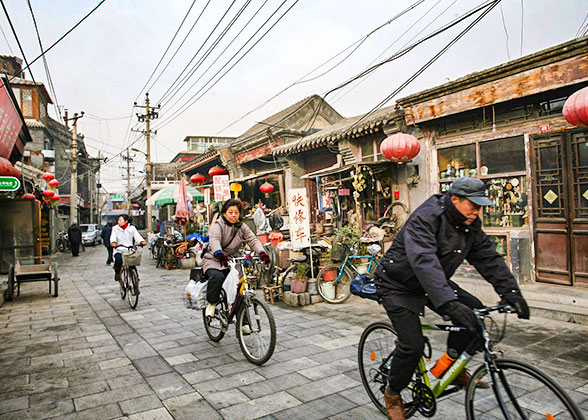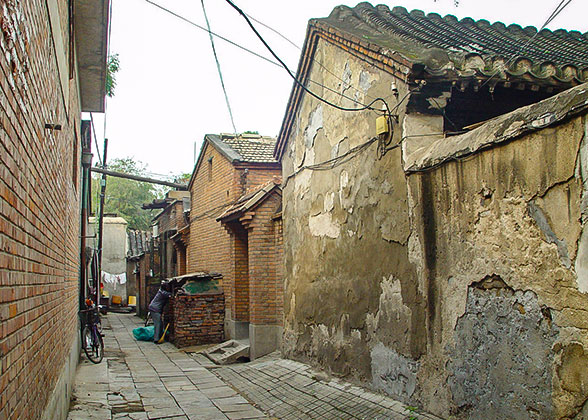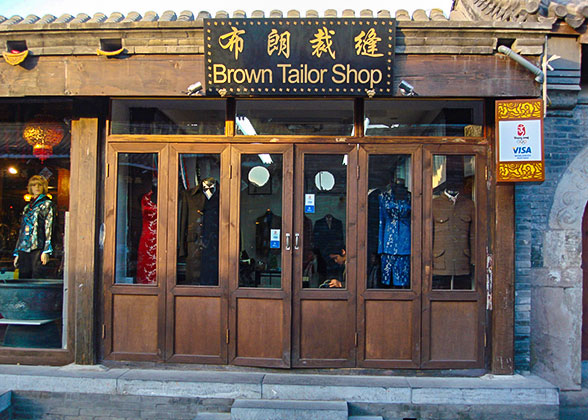History of Hutong
The history of Hutongs can be traced back to the Yuan Dynasty (1271 - 1368) when Beijing was the capital. After the establishment of the Yuan authority, the nobles and heroes were awarded with lands as feudal estates. They built houses and courtyards arranged orderly around the wells. Lanes in between houses were created in consideration of light, ventilation and easy accessibility. Though these countless lanes crisscrossed the old capital like a chessboard, there were only 29 of them called Hutong. As city planning was very strict at that time, roads measured 36 meters (39.4 yards) wide were called main streets. The 18-meter (19.7 yard) wide roads were named side streets and those nine meters (9.8 yards) wide or less were designated as Hutongs.
Later those people got accustomed to settling down around the well, so their original lifestyle – nomadism – was dropped. Different groups of people became stable communities and the cross lanes connected different courtyards, to form the rudiment of the city’s urban area.
These lanes were also places where grain was stored to satisfy the needs of the royal court and armies and to feed the starving populace in lean years. For example, Lumicang Hutong became famous because it was the location of Lumi Grain Depot. Built in the Ming Dynasty (1368 - 1644), it measured over 200 meters (218.7 yards) long, half of which is occupied by the Lumi Grain Depot.
It was in the Ming (1368 - 1644) and Qing (1644 - 1911) Dynasties that the Hutongs dramatically expanded. Based on the layout of Yuan Dynasty, the central government of Ming Dynasty built an outer court as a supplement to the inner city. Due to this construction, more people began to live in the outer court. More varieties of lanes were built to ease people’s life. The number of Hutongs is three times more than that in the Yuan Dynasty.
The naming of Hutongs is not as strict as in the Yuan Dynasty, so almost all kinds of passages can be called so. Some lanes, such as Pocket (Koudai) Hutong only had one entrance. Others, such as Nine Turnings (Jiudaowan) Hutong had many twists and turns. Yet, others wound around a somewhat squared off circle like the Four Rings Hutong. Peddlers sold their wares along these lanes. All these basically resulted in the general appearance during these periods.
After the formation of the Qing Dynasty, the central government drove the Han and Hui people out of the city and made the inner city the Manchu’s meeting place. Hence, other nationalities had to build their houses out of the city, which led to fast development of these typical lanes outside Beijing city. The number of lanes inside and outside the city increased to about 2,000. Except the local people, some businessmen and candidates lived there, which made the outer city more prosperous.
From the end of the Qing Dynasty to early 1949, the number of Hutongs increased rapidly to about 3,000. After 1949, the rapid development of Beijing City promoted the construction of the lanes, making the total number to over 6,000. However, the number decreased rapidly due to the urbanization of the city in the later years. Up till 2003, there are only 1,571 lanes left but no more than 1,300 to date. These lanes had been overtaken by modern buildings over the years and people have moved out gradually too. Only the famous ones are preserved and converted into tourist spots.
 |
Later those people got accustomed to settling down around the well, so their original lifestyle – nomadism – was dropped. Different groups of people became stable communities and the cross lanes connected different courtyards, to form the rudiment of the city’s urban area.
These lanes were also places where grain was stored to satisfy the needs of the royal court and armies and to feed the starving populace in lean years. For example, Lumicang Hutong became famous because it was the location of Lumi Grain Depot. Built in the Ming Dynasty (1368 - 1644), it measured over 200 meters (218.7 yards) long, half of which is occupied by the Lumi Grain Depot.
It was in the Ming (1368 - 1644) and Qing (1644 - 1911) Dynasties that the Hutongs dramatically expanded. Based on the layout of Yuan Dynasty, the central government of Ming Dynasty built an outer court as a supplement to the inner city. Due to this construction, more people began to live in the outer court. More varieties of lanes were built to ease people’s life. The number of Hutongs is three times more than that in the Yuan Dynasty.
 |  |
After the formation of the Qing Dynasty, the central government drove the Han and Hui people out of the city and made the inner city the Manchu’s meeting place. Hence, other nationalities had to build their houses out of the city, which led to fast development of these typical lanes outside Beijing city. The number of lanes inside and outside the city increased to about 2,000. Except the local people, some businessmen and candidates lived there, which made the outer city more prosperous.
From the end of the Qing Dynasty to early 1949, the number of Hutongs increased rapidly to about 3,000. After 1949, the rapid development of Beijing City promoted the construction of the lanes, making the total number to over 6,000. However, the number decreased rapidly due to the urbanization of the city in the later years. Up till 2003, there are only 1,571 lanes left but no more than 1,300 to date. These lanes had been overtaken by modern buildings over the years and people have moved out gradually too. Only the famous ones are preserved and converted into tourist spots.
- Last updated on Aug. 16, 2024 by Gabby Li -